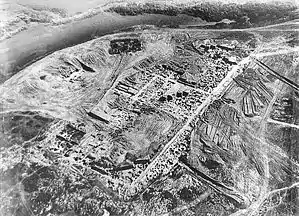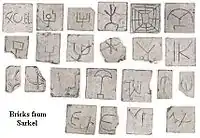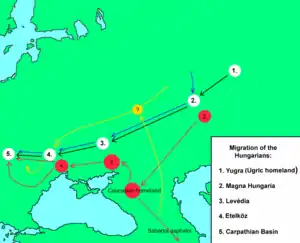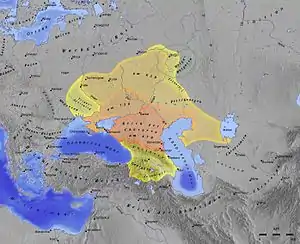Sarkel
Sarkel (or Sharkil, literally white house in Khazar language)[1] was a large limestone-and-brick fortress in the present-day Rostov Oblast of Russia, on the left bank of the lower Don River.
Sharkil | |
 Aerial photo of the excavations conducted at Sarkel in the 1930s. | |
.svg.png.webp) Shown within European Russia | |
| Location | Russia |
|---|---|
| Region | Rostov Oblast |
| Coordinates | 47°42′18″N 42°16′23″E |
| Type | Fortification |
| History | |
| Builder | Khazars, Byzantine Empire |
| Founded | 830s |
| Cultures | Khazar |
| Site notes | |
| Excavation dates | 1930s |
| Archaeologists | Mikhail Artamonov |
| Condition | Submerged by Tsimlyansk Reservoir |

It was built by the Khazars with Byzantine assistance in the 830s or 840s.[2] It was named Sarkel, or 'white-house', because of the white limestone bricks used in its construction.
Location
Sarkel was located on a hill, on the left bank of the Don River. It is currently under water, after the construction of the Tsimlyansk Reservoir.
Across the Don River from Sarkel, on the right bank, there was located another large Khazar fortress roughly contemporary with Sarkel. This site is known as Pravoberezhnoye Tsimlyanskoye site, although its ancient name is unknown.[3]
Construction
Sarkel was built to protect the north-western border of the Khazar state in 833. The Khazars asked their ally, Byzantine emperor Theophilus, for engineers to build a fortified capital, and Theophilus sent his chief engineer Petronas Kamateros. In recompense for these services, the Khazar khagan ceded Chersonesos and some other Crimean dependencies to Byzantium. Historians have been unable to determine why such a strong fortress was built on the Don.
History
.jpg.webp)
The city served as a bustling commercial center, as it controlled the Volga-Don portage, which was used by the Rus to cross from the Black Sea to the Volga and thence to the Caspian and Baltic.[4] The route was known as the "Khazarian Way". A garrison fortified at Sarkel included Oghuz and Pecheneg mercenaries.
Sarkel's fortress and city were captured by Kievan Rus' under prince Sviatoslav I in 965. The city was renamed Belaya Vezha (Slavic for White Tower or White Fortress) and settled by Slavs. It remained Slavic until the 12th century, when the district was taken over by the Kipchaks.
The site is now submerged by the Tsimlyansk Reservoir, completed in 1952, so no further excavations may be conducted.
See also
Notes
- D.M. Dunlop, The History of the Jewish Khazars, Princeton University Press (1954). According to Károly Cseglédy, "Šarkel: An Ancient Turkish Word for 'House'" in D.Sinor, ed., Aspects of Altaic Culture (Uralic and Altaic studies no. 23) (Bloomington and the Hague, 1963), pp. 23-31, shar is related to Chuvash shura 'white' and kel/kil is borrowed from Middle Persian gil 'house.'
- D.M. Dunlop and Arthur Koestler both date the construction to around 833 (Dunlop 186; Koestler, The Thirteenth Tribe, Random House (1976), p. 85); Peter B. Golden states Sarkel was built 'with Byzantine assistance in 840-41' ("The Conversion of the Khazars to Judaism", in: Peter B. Golden et al. The World of the Khazars. New Perspectives, Brill (2007), p. 150); and Marcel Erdal provides the date 838 ("The Khazar Language", in: Peter B. Golden et al. (2007), p. 85).
- V.S. Flyorov (2017), «Building Materials of Byzantian Origin in Khazar Fortresses of the Lower Don» (English summary of article in Russian)
- Thunberg, Carl L. (2011). Särkland och dess källmaterial. Göteborgs universitet. CLTS. pp. 20-22. ISBN 978-91-981859-3-5.
References
- Brook, Kevin Alan (2006). The Jews of Khazaria. 2nd ed. Rowman & Littlefield Publishers, Inc. ISBN 0-7425-4981-X
- Dunlop, Douglas M. (1954). The History of the Jewish Khazars. Princeton, N.J.: Princeton University Press.
- Dunlop, Douglas Morton (1997). "Sarkel". Encyclopaedia Judaica (CD-ROM Edition Version 1.0). Ed. Cecil Roth. Keter Publishing House. ISBN 965-07-0665-8
- Erdal, Marcel (2007). "The Khazar Language", in: Peter B. Golden et al. (eds.). The World of the Khazars. New Perspectives. Brill. pp. 75-108.
- Golden, Peter B. (2007). "The Conversion of the Khazars to Judaism", in: Peter B. Golden et al. (eds.). The World of the Khazars. New Perspectives. Brill. pp. 123-162.
- Grousset, René (1970). The Empire of the Steppes: A History of Central Asia. (transl. Naomi Walford). New Brunswick, New Jersey: Rutgers University Press. ISBN 0-8135-0627-1
- Koestler, Arthur (1976). The Thirteenth Tribe Random House. ISBN 0-394-40284-7
- Thunberg, Carl L. (2011). Särkland och dess källmaterial. Göteborgs universitet. CLTS. pp. 20-22. ISBN 978-91-981859-3-5
- Vernadsky, George. A History of Russia. (online)

